"Save me, God!".
Thank you for visiting our website, before you start studying the information, please subscribe to our Orthodox community on Instagram, Lord, Save and Preserve † - https://www.instagram.com/spasi.gospodi/. The community has more than 60,000 subscribers. There are many of us like-minded people and we are growing quickly, we post prayers, sayings of saints, prayer requests, and timely post useful information about holidays and Orthodox events... Subscribe. Guardian Angel to you!
St. Daniel's Monastery is one of the oldest Moscow monasteries. It was founded in the 13th century by Holy Prince Daniel of Moscow. The first temple of the monastery was erected in honor of the venerable founder Daniel the Stylite. Today the Orthodox building has the status of stauropegia. The rector is the Moscow bishop - the Patriarch of Moscow and All Rus'. And the managing viceroy, the archimandrite, is in charge of the daily life of the community.
The monastery has a communal rule, which means common meals, prayers, and work for all the brethren. Anyone can attend the service. They happen daily. You can also come to the excursion service, where you can see the Sunday school, publishing house, church workshops, churches, catechetical courses and icons of the Danilov Monastery.
The best article for you, go to: Raifa Bogoroditsky Monastery
History of the monastery
As already mentioned, the building was founded in the 13th century. The founder was Daniil Moskovsky. During his lifetime, the prince was a peace-loving, humble and meek ruler. But he repeatedly took military action, repelling the attacks of Tatar raiders. During his fruitful life, he made a lot of efforts to unite the Moscow principality.
Before his death, the prince became a monk and was buried in his temple. Since the 1650s, the princely relics have been in the Danilov Monastery, and are there to this day. You can visit them in the Church of the Holy Fathers of the Seven Cathedrals, which is located on the territory of the monastery.
There was also the old Danilovskoye cemetery. Many famous people are buried there, in particular:
- philosopher, Slavophile A.S. Khomyakov;
- writer N.V. Gogol;
- painter V.G. Perov.
But with the advent of Soviet power, the necropolis was completely destroyed in the 40s of the twentieth century. Also at this time, the communists closed the abbey and organized a colony for young thieves and criminals on its territory. For almost half a century, the activities of the sanctuary were prohibited. In the 80s, Brezhnev signed a decree on the restoration of the Orthodox monastery.
It took the monastic brethren about 5 years to recover. In 1988, the churches of the Danilov Monastery became the center of the celebration of the 1000th anniversary of the Baptism of Rus'. Today it is one of the main spiritual centers of the Russian Federation.
The best article for you, go to: Church of the Holy Sepulcher Jerusalem
Danilovsky Monastery in Moscow
Vladimir Nikolaevich Kireev. St. Daniel's Monastery
On March 17, the Russian Orthodox Church celebrates the day of the death of the Holy Blessed Prince Daniel of Moscow. During his reign (1276-1303), Moscow gained the princely throne and became an independent Russian appanage principality after the annexation of Kolomna and Pereyaslavl-Zalessky. And Prince Daniil himself became the first Grand Duke of Moscow and “the founder of the Moscow princely house,” according to the definition of Russian pre-revolutionary historians.
In Moscow, in the name of the holy prince, the chapel of the cathedral church of the Seven Ecumenical Councils of the Danilovsky Monastery, founded by him in Zamoskvorechye, near the Serpukhov outpost, was consecrated. This is the oldest, very first Moscow monastery, built in our city in 1282. Although there is another, less substantiated version, that its foundation occurred later, in 1298-1300: then the first Moscow monastery is the Epiphany monastery near the Kremlin in present-day Kitai-Gorod, also founded by Prince Daniil in 1296 (see our publication dated 19 January this year).
Holy Prince Daniel of Moscow was the youngest son of St. Alexander Nevsky. He was born in Vladimir in 1261 and, already at the age of eleven, received Moscow by division between his brothers. In 1282, on the banks of the Moscow River, he built a church in the name of St. Daniel the Stylite, his heavenly patron, and founded a monastery with her.
St. Daniel's Monastery.
Prince Daniel, remembering the words of his father that “God is not in power, but in truth,” strove for peace and peacefulness. The main task of his life was to strengthen and consolidate Moscow as an independent principality - already the eldest son of St. Daniel of Moscow, Ivan Kalita, achieved for Moscow a label for the great reign, and previously unnoticed Moscow became the Russian capital until the time of Peter I.
Following the example of his father, before his death, St. Prince Daniel accepted the monastic rank and schema and died on March 4, 1303 (old style). According to his will, the prince was buried in the simple fraternal cemetery of the Danilovsky Monastery that he had built - “not in the church, but in the fence.”
His son, Ivan Kalita, in 1330 transferred his father's monastery to the Kremlin, behind the impregnable walls, where he was safer from raids, and assigned it to the Cathedral of the Savior on Bor. And he entrusted the old Zamoskvorechensk monastery with the grave of Prince Daniil to the jurisdiction of the archimandrite of the new Kremlin monastery. The remote monastery decayed and became empty and soon began to be called simply “the village of Danilovskoye,” and the prince’s tomb was eventually abandoned by his descendants.
Only under Ivan III did a significant event take place, which began the gradual revival of the oldest Moscow monastery and special veneration of the memory of Prince Daniil of Moscow, even before the discovery of his venerable relics and his canonization. According to legend, Ivan III once rode with his servants along the Moscow River - past the place where the grave of Prince Daniil once was. Suddenly, a horse stumbled under one rider, the servant fell to the ground, and an unknown prince appeared to him, saying: “I am the lord of this place, Prince Daniel of Moscow, who has been placed here. Tell Grand Duke Ivan: you are comforting yourself, but you have forgotten me!”
Having learned about this, the Grand Duke ordered to serve cathedral memorial services for his deceased ancestors and distribute alms at the memorial. Since then, all Moscow princes began to serve memorial services for their ancestor, Prince Daniil.
Church of the Holy Fathers of the Seven Ecumenical Councils. Photo: www.saintdaniel.ru
And soon, under the son of Ivan III, Grand Duke Vasily III, another miraculous event occurred. One day he and his retinue were driving past the grave of Daniil of Moscow. One of the boyars accompanying him, Ivan Shuisky, dismounted from his horse and could not get back into the saddle. Then he decided to stand on the tombstone of St. Daniel to be higher. One passerby noticed to him that the Grand Duke Daniel was lying here, so that he would not dare to mount his horse from this stone. Shuisky did not listen and nevertheless stood on a stone, raised his leg, and the horse, suddenly rearing up, fell to the ground dead and crushed the boyar - so that he almost died and escaped death only after in this place, in front of the grave They served a prayer service. And yet the monastery itself was still in oblivion.
Finally, during the reign of Ivan the Terrible, son of Vasily III, a dying man was miraculously healed at the grave of Prince Daniel. Then the king ordered an annual religious procession to the burial of St. Daniel and serve a memorial service for him. And most importantly, he restored the ancient Danilovsky Monastery in Zamoskvorechye, ordering to build and consecrate a new cathedral church in the name of the Seven Ecumenical Councils, walls and fraternal cells - and to populate the renewed monastery with monks. Moreover, the Danilovsky Monastery, previously subordinate to the Kremlin Transfiguration Cathedral, now again became independent.
There is a version that the new monastery was built not exactly on the spot where the previous one stood, with the St. Daniel Cathedral Church, but five hundred meters north of it. Scientists believed that on the site of the Danilovskaya Church, built by the noble prince, they then built the now existing Church of the Resurrection of the Word in Danilovskaya Sloboda.
In 1555-1560 In the Danilovsky Monastery, a cathedral church was built in the name of the Seven Ecumenical Councils of the Holy Fathers, consecrated in May 1561 by Metropolitan Macarius in the presence of Ivan the Terrible and his family. The Tsar presented to the newly built monastery the Vladimir Icon of the Mother of God, letters from the royal icon painter, on which the stamps contained portrait images of Ivan the Terrible himself, his eldest son Tsarevich Ivan and Metropolitan Macarius of Moscow.
The monastery wall, built at the behest of Ivan the Terrible, turned the monastery into a military fortress. In 1606, Prince Skopin-Shuisky carried out a successful military operation here - he gathered all the regiments here, and then brought out and unexpectedly surrounded the enemy. During the Time of Troubles, the Poles severely devastated the Danilovsky Monastery, and it survived in no small part thanks to the generous contributions that all the kings from Ivan the Terrible gave it in memory of their ancestor.
Holy Blessed Prince Daniel of Moscow
According to legend, in 1652 St. Prince Daniel appeared in a dream to Tsar Alexei Mikhailovich - by his command, on August 30 of the same year, Patriarch Nikon with a council of bishops in the presence of the tsar opened the tomb of the prince, and his holy relics were found incorrupt. Many people were healed by them at that time. The holy relics of Prince Daniel were solemnly transferred to the cathedral church of the monastery and laid to rest in a wooden tomb near the right choir. At the same time, the noble Moscow prince was canonized, and his celebration was established twice a year - in March in memory of his death and in August (September 12, new style) - on the day of his discovery of St. relics.
In the same 17th century, the monastery itself was heavily fortified and renovated. Firstly, a new cathedral was built, which has survived to this day. For a long time, scientists argued whether the current cathedral church of the monastery was basically the first building from the time of Ivan the Terrible, or whether it was rebuilt under Alexei Mikhailovich. Only during the restoration of the monastery were the remains of the foundation of the first cathedral, erected by order of Grozny, discovered - to the north of the building of the current cathedral. Thus, it turned out that the current cathedral of the Danilov Monastery was built in the second half of the 17th century. At the same time, Tsar Alexei Mikhailovich built the Intercession Church in the monastery. As an old local historian wrote, it is “especially beautiful for its architecture of purely Russian style in its best period.”
At the end of the 17th century, the Danilovsky Monastery was surrounded by a new beautiful brick wall with towers. Muscovites even compared it to the Kremlin fortress wall. In addition, pre-revolutionary restorers discovered in this monastery many gravestones with inscriptions in foreign languages. It is believed that the oldest heterodox cemetery in Moscow was not far from the Danilovsky monastery.
First service of St. Daniel was compiled by the rector of the monastery, Archimandrite Constantine, in 1761, but forty years later, Metropolitan Platon (Levshin) compiled the life of the holy Prince Daniel and a new service. Every Sunday an akathist was read before his holy relics. And on the day of remembrance of the blessed prince, a religious procession was sent from the Kremlin cathedrals to the Zamoskvorechye monastery every year.
Over time, in the cathedral church of the monastery, a chapel was consecrated in the name of St. Daniel of Moscow, and a silver frame was made on his tomb, moved to the left choir, with a donation from Prince Fyodor Golitsyn. It was stolen by Napoleonic warriors, and in 1817 St. the relics of Prince Daniel were placed in a new silver shrine. On the wall was an icon of St. Prince Daniel, painted in full length on the former upper lid of his wooden tomb.
Trinity Cathedral. Photo: www.saintdaniel.ru
And the three-tiered church of St. Daniel the Stylite was erected over the porch and porch of the cathedral church only in the 18th century - in memory of the first, oldest church of the monastery. It is this century, like the next 19th century, that is called the heyday of the ancient Danilovsky monastery. Then a bell tower and new churches were built here, including the Church of the Holy Life-Giving Trinity, erected in 1833 at the expense of the Shustovs and Kumanins. The latter were related to Fyodor Mikhailovich Dostoevsky - Kumanin’s wife was the writer’s aunt and was his godmother. Trinity Church, consecrated by Saint Philaret himself, was built by O.I. Beauvais, shortly before his death, became one of the last buildings of the great architect. Previously it was believed that it was built by the no less famous Evgraf Tyurin, who built the house church of St. Tatiana of Moscow University on Mokhovaya and Epiphany Cathedral in Yelokhov.
In 1771, during the Moscow plague epidemic, a city cemetery was built at the Danilovsky Monastery for those who died from this disease, since it was located in a place quite remote from central Moscow. When the plague left the city, the cemetery was filled up, but since then the tradition of burying not only monks, but also lay people in the monastery has remained. And over time, a cemetery similar to an ordinary city one appeared here again, where rich and noble people were buried.
Slavophiles Yu.F. Samarin and A.S. Khomyakov, poet N. Yazykov, musician N.G. found their final refuge at the Danilovsky churchyard. Rubinstein, the founder of the Russian Musical Society, the forerunner of the Moscow Conservatory, artist V.G. Perov and the most famous layman here - N.V. Gogol. The coffin with his body in his arms was brought here, to Zamoskvorechye, from the university Tatiana Church on Mokhovaya, where Gogol was buried as an honorary member of Moscow University. It was only in 1953 that Gogol’s remains were moved to the Novodevichy Cemetery, like other people buried here. But this happened already under Soviet rule.
Before the revolution, the ancient Moscow monastery saw many hardships. In 1812 it was occupied by enemy officers. And although all the main treasures were taken to other cities on the eve of Napoleon’s entry into Moscow, much valuable stuff still remained in the monastery itself. The French commanders who stayed there for some reason warned the brethren that they were expecting an even larger group of military men here, and that the people were “dishonest” in the majority and would steal everything they found. And they themselves helped the monks bury valuable things and utensils in the ground. The new arrivals actually robbed everything that was left, including even the antimensions.
A new misfortune came to the monastery with the revolution. As is known, after 1917, the Danilovsky Monastery sheltered within its walls many clergy expelled by the Bolsheviks from church departments because they did not accept the ideology of “renovationism” and remained faithful to the traditions of Russian Orthodoxy. They were called “Danilovites” - many of them were later sent into exile and imprisonment.
The oldest Moscow monastery was closed only in 1930, the very last in Moscow and almost all of Russia. Relics of St. Daniel of Moscow disappeared after the closure of the monastery. Back on August 30, 1917, on the feast of St. Daniel, Metropolitan of Moscow Tikhon (Belavin), the future His Holiness Patriarch, transferred his relics to the monastery Trinity Church. After 12 years they were again placed in the chapel of St. Prince Daniel, and in 1930 they were moved to the aforementioned Church of the Resurrection outside the monastery. Perhaps the believers themselves took them from there to save them from desecration.
In 1931, a monument to Lenin was erected in the monastery courtyard, and instead of monks, juvenile delinquents settled within the walls of the oldest Moscow monastery - a children's colony was set up here. The new numerous inhabitants were cramped in the former monastic cells and monastery chambers, sometimes they even had to dine directly on the gravestones instead of tables.
Then, to expand the “useful” territory, it was decided to demolish the famous monastery cemetery. On May 31, 1931, in the presence of a special commission, the graves of Gogol, Rubinstein, Perov, Khomyakov and Yazykov were opened. Their ashes were transferred to the Novodevichy cemetery, only the artist Vasily Perov was reburied at the Donskoy Monastery cemetery. After this, the entire Danilovsky churchyard with the remaining graves was barbarically destroyed. The parish Church of the Resurrection was turned over to institutions, and at one time it housed an umbrella manufacturing plant.
Only in May 1983, by decision of the Soviet government, the Danilovsky Monastery was again given to the Moscow Patriarchate for the establishment of an official residence there. The story of his return is truly wonderful - Orthodox Muscovites saw in it the Will of Providence.
The over-kladeznaya chapel in honor of the 1000th anniversary of the Baptism of Rus' on the monastery square. Photo: www.saintdaniel.ru
The fact is that Brezhnev signed a decree on the return to the Patriarchate not of Danilovsky, but of the Donskoy Monastery. He put this signature at the very beginning of November 1982, and on November 10 of the same year he died. And a change of decision followed - the Danilovsky Monastery was given to the Church. It so happened that the very first Moscow monastery, founded by the first Grand Duke of Moscow, and closed by the very last in Moscow during the years of persecution, was reopened by the very first in our city!
The children's reception center, leaving the monastery walls, had to take with them a monument to Lenin. When they began to lift the plaster monument with a crane, it burst and shattered into small fragments. It was in its place in 1988, according to the design of architect Yu.G. Alonova, a chapel was erected in memory of the 1000th anniversary of the Baptism of Rus'.
It has not yet been possible to find the graves destroyed during the demolition of the cemetery. The chapel-ossuary, built in 1988 according to the design of the same architect Alonov, became a symbolic tombstone for all those buried in the monastery, and two bas-reliefs were installed in their memory next to the graves of Gogol and Khomyakov.
Already in May 1988, US President Reagan visited the Danilovsky Monastery during his visit to the USSR. And two weeks later, on June 12, 1988, celebrations were held here in honor of the 1000th anniversary of the Baptism of Rus'. The liturgy was celebrated in the open air.
The Danilovsky Monastery is now the residence of His Holiness the Patriarch; Bishops' Councils of the Russian Orthodox Church are held here.
The slipper of Spyridon of Trimifutsky in the Danilov Monastery
In the holy monastery you can see a lot of different churches and icons with pieces of the relics of Sergius of Radonezh, Nicholas Archbishop, Seraphim of Sarov, Matrona of Moscow, St. Luke. But the most surprising thing for all parishioners is the shrine of Spyridon.
Believers write a note with requests to the saint and leave them in the gap between the shoe and the image. They say that Spiridon helps many people this way.
Chapels and temples
- Temple of the Holy Fathers of the Seven Ecumenical Councils;
- Temple of St. Seraphim of Sarov (from the end of the 19th century);
- Temple of St. Simeon the Stylite (XVII century);
- Temple of Kyiv Vladimir;
- Church of the Life-Giving Trinity (since 1833);
- Church of All Saints (1988);
- Alonov Memorial Chapel 1988;
- Alonov's superkladeznaya chapel, 1988.
Sights and buildings on the territory
Today the territory is well-groomed and ennobled. But some types of restoration work continue to this day. Today, the bell tower in which the temple of St. Simeon the Stylite is located has been completely restored. The bells of this attraction deserve special attention. The fact is that it took about 200 years to create a magnificent bell ensemble. Today there are 18 of them. They all have different colors and tones.
The most important thing is the “Big” bell. Its weight is 12 tons. It was commissioned by the noble merchant Zakharova, in honor of her husband, who passed away. The second largest is the “Everyday” bell. Its weight is 2.5 tons. The remaining elements of the bell perform the bell function. Their weight varies from 30 to 500 kilograms. Among them there is one that was cast back in 1682. This was a gift from Tsar Feodor Alekseevich.
Each bell plays an important role in creating the melody. For example, the “Guard” fights off separately from the others. Its weight is 2300 kg. Therefore, it gives off a special, unique sound. This is quite a rare occurrence for an instrument with an impressive mass.
The monastery is surrounded by powerful and majestic fortress walls. In the evening, the backlight turns on. The snow-white towers look elegant when illuminated. There are passages left within the walls of the fortress. Visitors cannot use them. Many people feel the urge to walk through them.
The territory of the complex itself is quite compact. All objects are neatly arranged, forming a single and friendly ensemble. There are many stone buildings here. Despite the high density of buildings, the feeling of spaciousness is not lost. The paths around the shrines are neat and easy to walk. The lighting is well thought out and there are many benches. Many people stop to sit there in order to calmly think about something high and spiritual.
The oldest building on the territory is the Church of the Holy Fathers of the Seven Ecumenical Councils. The object was built back in the 17th century. It went through a long stage of restoration work and was illuminated. The architectural structure is distinguished by the complexity of its composition. The basement part of the 17th century is represented by the Church of the Intercession; there are two upper churches of the 18th century.
Above the holy gates of the monastery you will see a church in honor of Simeon the Stylite. Just above it you will see the bell tower. A slender high-rise building is a bright decoration of space.
The largest building is the Cathedral of the Life-Giving Trinity. During services it can accommodate up to 3,000 believers. The construction of the shrine was carried out according to the design of Osip Bove in the 30s of the 19th century. The building is famous for its monumentality and boasts luxurious decoration. It is made in the traditions of the Russian Empire style. Elegant Tuscan porticoes make the facade solemn.
On the western side there is a chapel above the vault. The building consists of two floors. The Patriarchal and Synodal residence is organized here. The upper tier is represented by the house church of All Saints. The chapel was erected for the 1000th anniversary of the Baptism of Rus'.
Also, the monastery has three perfectly preserved stone buildings. They are allocated for the monastic building, the hospital and the abbot’s chambers. On the square you will see a monument to Prince Vladimir and a stone - khachkar, brought here from Armenia.
The current condition of the territory is excellent. Today the monastery is active. Management is carried out by a viceroy with the rank of archimandrite. Services are held every day. Event times are 7.00 and 17.00. On Saturday and Sunday – at 8.45 and 17.00. On holidays the schedule may be adjusted.
The area is open to the public. You can come any day. There are many visitors from other cities. They ask not to take photographs or videotapes of monks, monks, or decorations. When attending a service, you must be guided by generally accepted standards of behavior. You should not make noise, conflict, or dress flashy. It is important for women not to forget about the headscarf.
There is a shop where you can buy all the necessary church utensils. Tasty and healthy monastery honey, books, icons, candles, brochures, paintings and many other products are sold here. The bell center runs courses. Anyone can sign up to learn bell-ringing skills. You will be able to study the rules of church services and hear the history of bell making. Theory and practice courses are accompanied by fascinating excursions to the holy places of the Golden Ring of Russia. Those interested are always welcome to attend the courses, so it’s convenient to sign up in advance.
In addition, the monastery offers two-year regency and singing courses. There is a Sunday school here and there is its own publishing center. The workshops are famous for their high-quality Orthodox products. There are also metochions of this monastery in other cities. They can be visited in Ryazan, Moscow region.
Shrines
The men's monastery contains a shrine, an ark and many different images with the relics of Daniel. Moreover, there is a shrine with the relics of Archimandrite George (Lavrov). He died back in the 1930s. This was a period of church repression. People come here for help from the oldest icon, which was created by isographers of the 15th century. It depicts the face of the Vladimir Mother of God. Also, a large number of pilgrims come to the velvet slipper of the wonderworker Spyridon of Trimifuntsky. It was brought here directly from the island of Corfu.
Social service
It functions at the monastery. It helps all people who suffer from alcohol and drug addiction. If you want to learn as much as possible about Orthodoxy, you can take the distance learning course “Orthodox Internet Course.” It was created through the efforts of the Patriarchal Center for the Spiritual Development of Children and Youth. There is a volunteer service. Volunteers take an active part in the life of orphanages, boarding schools, and hospitals.
Where to stay for the night?
If you want to enjoy the beauty of the monastery complex for as long as possible, then it is most convenient to stay at the Danilovskaya Hotel. It is located next to the shrine and has comfortable living conditions. The number of rooms is rich and varied. The building is modern. On its walls there are biblical images and scenes from their Gospel.
The rooms are simple but have all the necessary amenities. The cost of housing is reasonable. But perhaps the most important advantage is the incredibly beautiful view of the monastery. In the evening the lights turn on and the street is filled with a special atmosphere. You will wake up to the sound of a bell, and you won't need to set an alarm clock. Therefore, if you do not like to wake up early, take this nuance into account. The hotel boasts a well-equipped park. It has a pond, fountain and sculptures.
It's nice to stroll here on a cozy evening. There is a beautiful gazebo where you can also sit. Tourists here love to organize a photo shoot. This place is also popular with newlyweds. There are many spectacular flower beds around.
I want to enjoy the beauty of the Holy Danilov Monastery for an infinitely long time. It delights with its elegant, elegant, but at the same time strict architecture. The snow-white walls seem impregnable. Each building on the territory has its own history and is located in the right place. The holy spring has a modern appearance. There is beauty, tranquility and harmony all around. The gracious atmosphere fills the soul with humility and kindness.
How to get there
Take the Serpukhovsko-Timiryazevskaya line of the Moscow metro to Tulskaya station. Next, you need to go out onto Tulskaya Street and walk to Serpukhovskaya Zastava Square. From the square you need to turn to the right and move along Danilevsky Val Street. It is advisable to walk along the tram tracks, so you will get to the gates of the Danilovsky Cathedral. Despite the complexity of the path, its duration is about 10 minutes.
The best article for you, go to: Ioannovsky Monastery on Karpovka
The exact address of the Danilov Monastery is Russia, Moscow, Danilovskaya Val street, 22. The nearest metro station is Tulskaya. Index 115191.
His life tells us about the life of Spiridon
Cyprus became the birthplace of not only the pagan Aphrodite, but also one of the most revered Christian saints.
We know about the life of Spyridon from his life. He was born in Cyprus, in a village called Askia. From early childhood he fell in love with a solitary life and spent his time with the sheep that he tended.
Askia
this is the name of the village in Cyprus where Spiridon was born
He married a pious virgin and she bore him a daughter. But marital happiness was short-lived - Spiridon’s wife died suddenly. But he did not fall into despair and sorrow, strengthening his spirit with prayer.
Saint Spyridon of Trimifuntsky was a shepherd and therefore is depicted in icons wearing a shepherd’s hat
Schedule of services of the Danilov Monastery
It is worth noting that funeral services, weddings and baptisms are not performed here. But you can order the following prayers:
- prayer service;
- prayer service with akathist;
- note for liturgy;
- magpie;
- funeral service;
- for six months, for a year, for two years and for 5 years.
The holy monastery is open daily from 6:00 to 20:00. There is also a church shop open every day from 8:00. The wholesale department of the Danilovsky Temple is open only on weekdays from 10:00. A detailed schedule of services can be found by telephone or by personally contacting the priest or employees of the house of God.
May the Lord protect you!
You will also be interested in watching a video about the St. Danilov Monastery:
Where to stay
If you want to attend services, work in the monastery, or just stay in this wonderful place for a few days, you can use the services of the Danilovskaya Hotel, which is located in close proximity to the Orthodox monastery.
Quite a modern hotel building. But it is very unusual that both on the street and inside there are icons and paintings with biblical and evangelical scenes everywhere.
The rooms are quite simple,
and inside there are all the necessary amenities: a bed, bedside tables, table, refrigerator, TV.
But the most important advantage of the Danilovskaya Hotel is the amazing view from the window of the St. Daniel Monastery
and the Church of the Resurrection, standing separately. This temple is better known as the Temple of the Resurrection of the Word in Danilovskaya Sloboda.
How wonderful it is to wake up in the morning to the wonderful sound of bells! True, some hotel residents considered this event to be the main drawback. Everyone is different, so decide for yourself whether you like the chime alarm clock or not.









